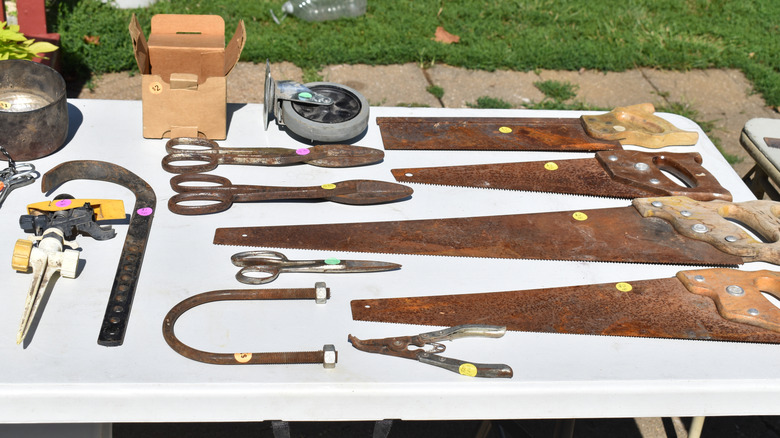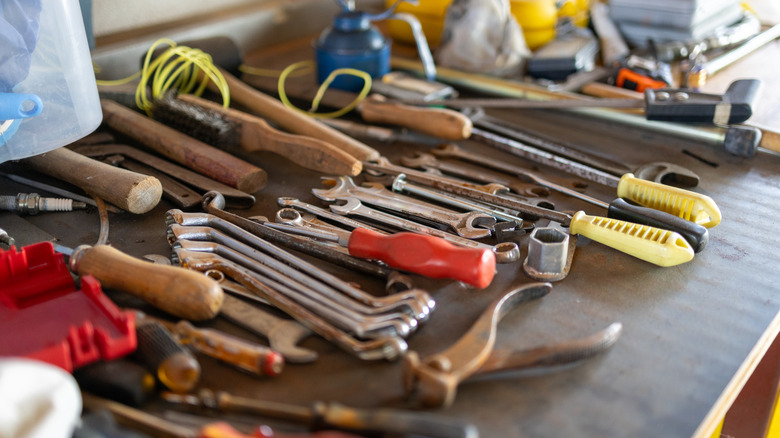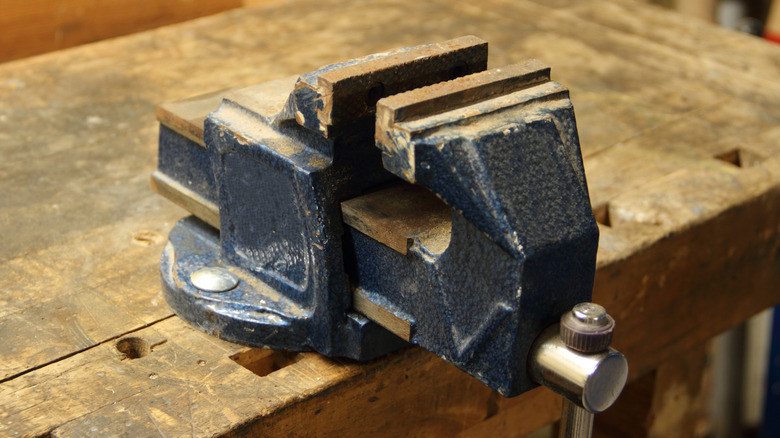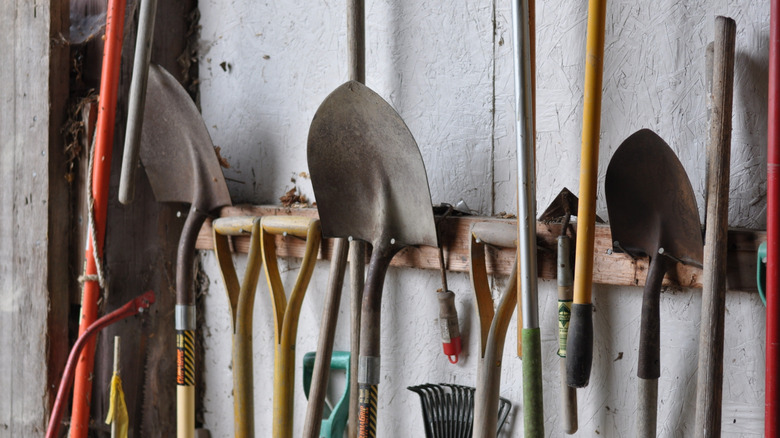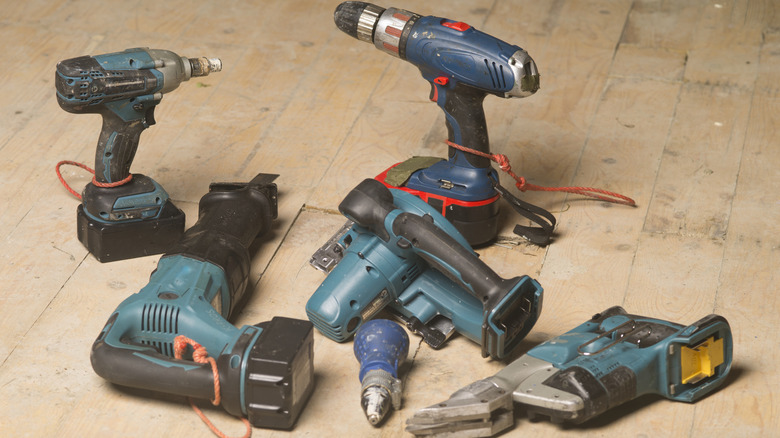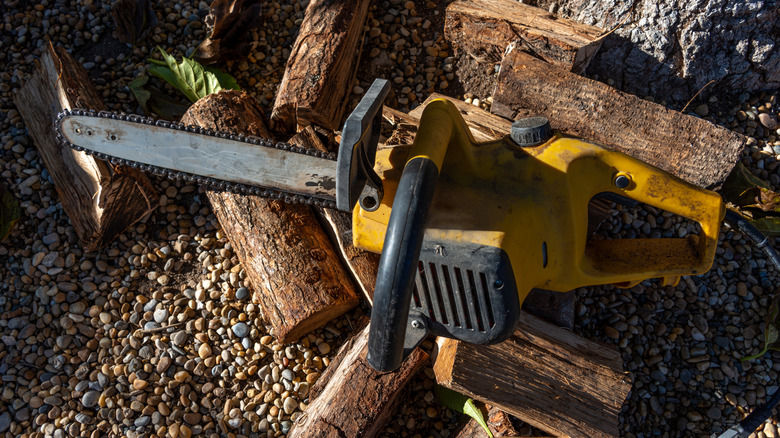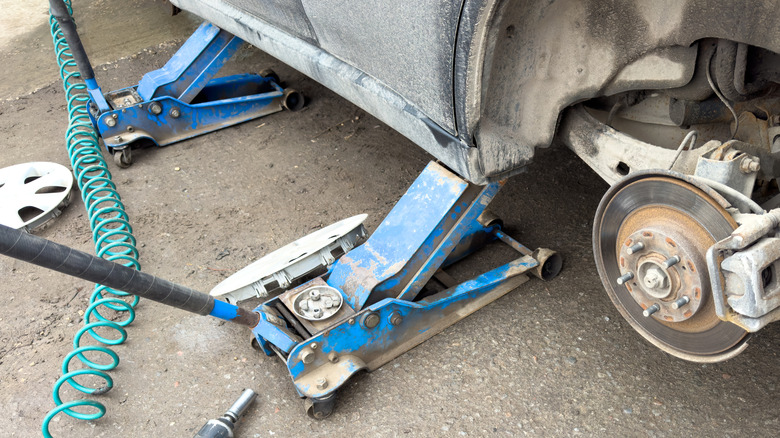3 Tools That Are Safe To Buy Used (And 3 You Never Should)
Building your personal tool collection is a great way to break into both specialty crafts and home DIY, but some tools have a tendency to run on the expensive side. Fortunately, there are plenty of great tools available on the used market that work just as well as the brand-new ones you find on hardware store shelves. Plus, you can get a lot of them for just a fraction of the price. Nearby garage sales, thrift stores, and local online markets such as Craigslist and Facebook Marketplace might hold a wealth of immaculate tools that you can find for pennies on the dollar, but you need to know what to look for.
Most of the simplest tools are designed to be sturdy and stand up to abuse for a long time without losing their functionality. Because of this, there are a lot of them out there that you can buy used without needing to worry too much about their condition. These kinds of tools usually don't have too many moving parts and are easy to inspect on site. A simple spot check for rust, cracks, and broken pieces, and you're off to the races.
That said, there are also a lot of other, more complex tools out there that are significantly riskier to purchase second-hand. These are usually products with a lot of moving parts, or ones where your safety relies on the certainty of the item's structural integrity. These are generally best avoided, particularly as the damage might be hidden somewhere you can't see. There are plenty of tool brands that are known for maintaining resale value and quality. However, it's also worth looking at the types of tools that are out there and considering which of them are safe to buy used and which are not.
Safe: hand tools
You can find some decent power tools on the second-hand market, but there are few items that you can buy with more peace of mind than a hand tool made from a single, solid piece of metal and some grips. There isn't a whole heck of a lot that can go wrong when purchasing a used hammer or wrench. Simply give the tool a quick once-over to check the steel for signs of corrosion or fractures. If everything looks solid, then you should be good to go.
The same goes for buying used mallets, sockets, chisels, pliers, pry-bars, screwdrivers, picks, and dozens of other handheld tools. If you can visually verify that the metal itself is in good condition, then you should be able to use the tool with confidence. You would want to check more delicate areas, such as the tip of a Phillips head screwdriver, to ensure that no part of the cross-shaped driver tip has been bent, broken, or worn down. Also, check the shaft to ensure that there are no major cracks or fractures. The same goes for any small pins or springs.
There are a few situations where these tools might still need a bit of love to get back in top shape, though. Blades, such as those found on used woodworking tools like chisels and hand planers, can easily be dulled or chipped through regular use. These might easily be re-sharpened and made back into a fine blade with a bit of work, but you'd need to be willing to put in the time and effort. Likewise, you can use a bit of WD-40 and steel wool to scrub rust off used tools, but you'll want to be careful if you can't tell how deeply the rust has permeated.
Safe: clamps and vises
Just about every trade craft requires you to own at least a few good clamps and vises. You can find some of the more affordable c-clamps and f-clamps at discount tool retailers like Harbor Freight for just a few dollars. However, some of the larger, more heavy-duty clamps and vises are usually going to cost a pretty penny if you want to buy them new. Pipe-clamps, for instance, usually run about $30 a piece, so getting them used is a great way to build up a sizable collection without breaking the bank.
There are even better deals to be had if you're looking for heavy-duty steel vises, since a good bench-mounted vise can run anywhere from a few hundred dollars to thousands. You can often find them used for significantly cheaper. A quick search on Facebook Marketplace yielded dozens of listings in my area, with several of them starting in the $45-$75 dollar range.
It's not impossible to break clamps and vises, but they are generally designed to be pretty strong. They have to be, in order to withstand the vast amounts of pressure that they apply to the objects that they're gripping. Like with hand tools, you just need to make sure that they are structurally sound and free of heavy corrosion. You'll want to pay particular attention to the slide, as it's possible for this to split if the previous owner did a lot of hammering on it. It's also always a good idea to test out any vises or clamps that you're thinking about purchasing second-hand. Make sure to bring a test piece along and have the vise or clamp grip it as tightly as you would expect it to grip your work pieces.
Safe: garden tools
Those who are looking to tackle some yard work or pick up gardening as a hobby can likely save quite a bit of money as well, since garden tools are another example of items that are relatively safe to purchase used. Shovels, rakes, hoes, trowels, and pruning shears are all typically designed to be fairly solid, and many of them have special powdered coatings over their metal components that are designed to help mitigate the corroding effects of moisture. They aren't completely invulnerable to damage, but they're built to be resistant to weather and wear from the rigors of hard manual labor.
Like with hand tools, you'll want to examine any used garden tools that you might be looking to buy in order to make sure they're structurally sound. Check any wooden shafts and handles for splitting, splintering, or rot. Tools made of ash or hickory are often seen as being particularly desirable. Check metal components for fractures and heavy amounts of corrosion.
You may need to spot remove a bit of rust and perhaps sharpen a few blades, but the amount of maintenance and upkeep required for these tools is minimal, which helps minimize potential damage in most cases. "The trick to buying secondhand garden tools is to look for solid construction on welded points and pay special attention to where the metal attaches to the handle," Judi Depeal of Mother Earth News. "If a tool has parts that are supposed to move, make sure they do. Another thing to look for on metal is heavy pitting and flaking, which weakens the metal so that the tool would be better suited for decoration than garden work."
Avoid: cordless power tools
You'll find a lot of cordless power tools on the market, and a good portion of them are probably perfectly functional. That said, there are a few reasons why you might want to reconsider purchasing them in this way. To start, the batteries (which may or may not be included) will become less effective over time and will eventually die–particularly those used by older tools that aren't Lithium-Ion based. These batteries are also quite fragile and can easily die if they're left exposed to the elements or stored too long in improper conditions. They may not hold a charge for long, or at all, and finding a replacement can be expensive, which defeats the purpose of buying the tool used in the first place.
Purchasing cordless power tools this way might still be tempting if you stumble across one that happens to be powered by a battery system that you already collect, but there are other concerns as well. Cordless power tools have complex internal electrical systems and motors that can encounter all kinds of issues, from water damage, to circuitry failures, to outright mechanical failures. What's more, this type of damage may be hidden away inside the tool's casing, where you won't be able to see it. Even the used (like new) tools on Amazon can be risky.
If you do decide to risk buying used cordless power tools, you should ask to test them and ensure that they work. Even in these cases, however, you will still be taking on a certain amount of risk. Most power tool companies only provide warranty coverage to the tool's original buyer. So, even if you get a newer tool used and starting in relatively good shape, you won't be protected from manufacturing failures that appear later.
Avoid: chainsaws
There are a lot of different power tools that you can buy used in relative safety, but chainsaws present a few unique risks that you might want to avoid. It doesn't matter if the chainsaw is gas-powered, battery-powered, or electric. All of them can have internal damage that will make them a nightmare to repair if they haven't been properly maintained.
Erika of Married with Small Engines posted a series of videos where she explained the dangers of purchasing chainsaws second-hand. She claimed that there is a whole host of ways that these tools can be internally damaged that might not be apparent from the outside. They might have worn out bearings or seals, and the carburetors on gas-powered models can be a common failure point–especially if the previous owner has been using ethanol gas, or failing to remove old fuel prior to storage.
In addition to the internal mechanical failures, used chainsaws will often need to have the bar and/or chain replaced to wear. These parts can often be quite expensive, which significantly reduces the value proposition of buying used in the first place. These kinds of problems are difficult to diagnose, and some might cost more to repair than the price of a new tool. Some users who are comfortable with small gas engine repair might be willing to get a cheap chainsaw with the knowledge that they may need to crack it open and perform some repairs and overdue maintenance, but other buyers will likely be willing to shell out a few extra bucks for a new one–particularly if they're concerned about the associated safety hazards.
Avoid: jacks and jack stands
Another thing to consider is what the consequences of a tool failing will be. If a screwdriver breaks, you lose a screwdriver, and if a shovel breaks, you lose a shovel. But the consequences of a jack or jack stand breaking can be far more dire.
Hydraulic floor jacks and scissor jacks are used to raise vehicles and other heavy objects off the ground. This allows the user to perform basic maintenance such as changing a tire or inspecting the brakes, or simply lifting the vehicle high enough that you can slide jack stands underneath. Jack stands are typically stationary, and used to hold a vehicle securely off the ground for long periods of time while more involved maintenance is performed. This means that both of these products are designed to withstand heavy loads, but they have been known to fail, and it can be difficult to gauge the condition of internal components.
Metal fatigue, hidden cracks, worn seals, and internal rust can all be potential failure points which can lead to these jacks failing under load. The chances of this happening may be low, but jacks and jack stands are critical pieces of safety equipment, and you want to be certain that you can trust them to be in good condition. It's impossible to know for certain if a previous owner might have overloaded them or left them out to corrode in the weather. When using jacks, it's always a good idea to plan as if one of them is going to fail and have a backup jack just in case.
